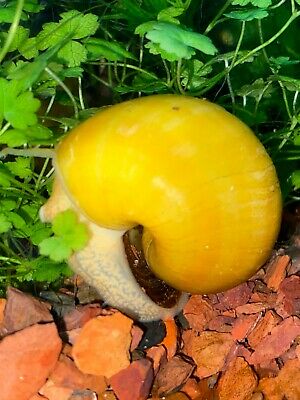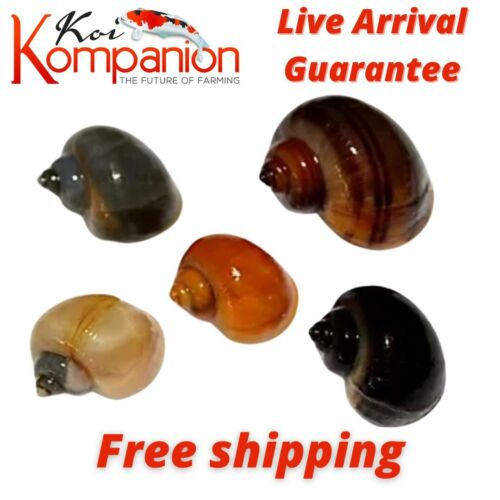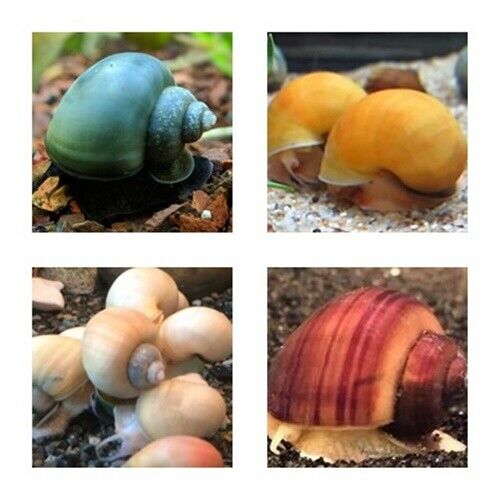-40%
Mystery Snails. Purple/Magenta/Blue/Gold/Ivory/Jade/Chestnut Tank Raised
$ 10.54
- Description
- Size Guide
Description
You willreceive
5 Happy and Health and home raised snails per order.
I CANNOT SHIP TO HAWAII OR PUERTO RICO.
If you live in these places please for the safety of the animals don’t order from me. I will have to just cancel the order and refund you every time. If I send them to Hawaii or PR on accident Customs holds them for about 2 weeks then sends them back to me dead EVERYTIME. These are ALL farm raised and taken well care of and I want them to have a good long life and a trip to these places never helps them with this. I would love to help but customs say NO and I care about the animal’s wellbeing.
Thank you for understanding: JLB-Aquaticlife
Short and Simple Description
Pretty Community snail, Lives with Community fish, likes to eat algae wafers and fresh cucumber or zucchini, likes pH from 6.5-8.3, water temps 68-84 and easy to breed but will not over take the tank as some snails do. Want a longer more in-depth description please read on.
What to Expect
As stated above, we generally ship young Mystery snails that are not yet fully grown, though the sizes of the snails you receive may vary from snail to snail.
There are commonly 5 different colors of Mystery snails: Golden, Blue, Black, Purple, Ivory White, and Albino which have a white body with a striped brown shell.
Species:
Pomacea Bridgesii
Size:
Mystery snails can grow up to a maximum diameter of 2 inches or more. Some specimens may stay around 1 to 1 ¼ inches in diameter. Most of the Mystery snails we ship out are young and range from ½ to 1 inch in diameter on average. Smaller younger snails will have a longer life time in your tank simply because they are younger.
Recommended Tank Parameters
pH level range:
7.0 to 8.4
Temperature range:
68° to 84° F
Water type:
kH 12-18; gH 8-18 (Mystery snails do best in hard water)
Category:
Rating
Care Level:
Beginner
Temperament:
Calm
Color Form:
Brown, Black, Blue, Purple, Gold and White
Lifespan:
About 2-3 Years
Size:
Max 2 Inches (we ship young snails 1/2" to 1")
Diet:
Herbivore
Family:
Ampullariidae
Minimum Tank Size:
5 Gallon
Tank Set-Up:
Moderate Vegetation, Adaptable
Compatibility:
Community Tanks
CAUTION:
Snails are very sensitive to copper & parasite treatments.
Mystery Snail Tank Mates: Peaceful
Mystery Snail tank mates include shy, peaceful non-aggressive freshwater community tank fish. Tank mates can include freshwater shrimp like: Bamboo Shrimp, Vampire Shrimp, Amano Shrimp, Ghost Shrimp, and Red Cherry Shrimp. Other tank mates can include other freshwater snails like: Nerite Snails, Ramshorn Snails, Ivory Snails, Trumpet Snails and Gold Inca Snails, for example. As for fish, regular calm community tank fish can be good choices as are bottom feeders and algae eaters such as Cory Cats and Otocinclus Catfish.
Tank mates to AVOID:
Goldfish and aggressive crayfish, Striped Convicts, Jack Dempsey, Oscars and other cichlids should be avoided. They may attack a Mystery Snail and can pick at the snail, yanking off its eyes, tentacles or both. Or worse, they can eat the Mystery Snail outright.
Feeding
Mystery snails are completely safe to keep with live plants as long as enough food is available for them; however, they have been known to munch on plants if they get hungry enough. Giving them fish food is a great way to deter them from eating your live plants. Other than algae and biofilm, they also eat fish/invertebrate pellets, algae wafers, and blanched vegetables such as zucchini, kale, spinach, or cucumber. Mystery snails have a very keen sense of smell and will rush toward food as soon as it is dropped in the water.
How to acclimate to your tank:
Float the snails in the bag in your tank for about 20 minutes to allow the water temperature in the bag to adjust to match that of your tank.
Remove the snails from the bag and when adding your new pets please place your Mystery Snails Right-Side Up. An often-overlooked Mystery Snail care issue involves how a snail is added to a tank. Its best to place the snail right-side up on the tank bottom, as opposed to simply dropping it in and letting it land how it lands. Completely upside-down Mystery Snails often have a difficulty righting themselves when coming out of their shells. A Mystery Snail will open its operculum and try extending its foot to reach hard surfaces like gravel or substrate. If the Mystery Snail’s foot cannot reach a hard surface, the snail may be unable to turn right side up. If too much time passes, the Mystery Snail may die. Mystery Snails laying partially on their sides seem to fare better, but the best practice it to make sure the snail is upright when placed in the tank bottom.
Mystery Snail Diet, Feeding & Habitat
A Mystery Snail seems content living in a planted aquarium. A Mystery Snail is a scavenger and live plants never let a tank stay “too clean”. Thanks to the vegetation, there’s almost always a plentiful source of food. Shed plant matter accumulates on the tank bottom for snails to eat. The Mystery Snail diet can be based on detritus and debris from this source.
Supplements and Blanched Vegetables
: Even if naturally occurring food sources are preset, a Mystery Snail diet also should include combinations of bottom feeder tablets, pellets, fish flakes, and algae wafers to help provide a balanced diet. In addition to store bought food, a Mystery Snail diet can have washed soft blanched vegetables such as green zucchini squash, leaf lettuce and iceberg lettuce. Each snail is different so test different vegetables to see what works. Generally, if a snail is not interested in a vegetable or food supplement after a day remove it from the tank. Leaving uneaten food in the tank can cause water quality issues relatively quickly.
Hardy Plants Work Well
A Note About Mystery Snails and Live Plants: Some hobbyist say that Mystery Snails will devour live aquarium plants. Since the term “Mystery Snail” is sometimes used loosely in pet stores, its tough to know whether a particular snail will eat live plants. Other factors have to do with the type of plants in the tank and how well fed the snail is. Well-fed Mystery Snails getting a balanced diet may be less likely to eat plants until they are ruined. If a Mystery Snail is interested in eating away plants, it should be less of an issue with hardy, durable hard-leaf plants like Anubias Barteri.
On the other hand, soft delicate plants like floating Salvinia may be more apt to be eaten. Maybe keeping a supply of floating Salvinia in the tank may be the plant a snail goes for, leaving the other plants alone. Different hobbyists have different experiences with Mystery Snails and plants, so it’s good to ask the store clerk before buying.














